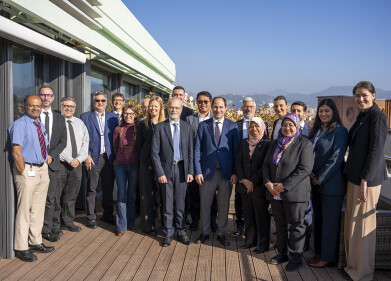Air clean up
What Is a Forest City?
Aug 30 2017
China has announced its latest innovative measure designed to fight the country’s long-standing air pollution problem through the construction of a “forest city”. Designed by Italian architect Stefano Boeri, the entirely fabricated metropolis will contain over 40,000 trees and one million plants.
At its heart, the scheme is intended to subvert the notion that urban areas are more prone to poor air quality, by introducing natural measures to consume that pollution as it is emitted.
Turning the tide
China has long struggled with air quality issues. Over a million premature deaths are attributed to poor air quality in the country each year and in 2011, it was discovered that Chinese power plants emit as much nitrogen oxides (NOx) as all the passenger cars in the world.
Just last year, the Chinese government placed the first ever “red alert” for air quality in the capital Beijing, closing schools and factories and orderin half of the cars off the road for a temporary period. In the wake of that event, the government has introduced a series of measures aimed at curbing their alarming emissions.
As well as championing renewables as a form of energy, the authorities are also looking at more innovative solutions. This forest city is just the latest in a string of such ideas.
The greenest of cities
Architect Stefano Boeri has already overseen the construction of two “forest skyscrapers” in his native Italy and has now set his sights on employing the same idea on a citywide scale. The new metropolis will be built in northern Liuzhou along the banks of the Liujiang River.
Once completed, it will contain a million plants of over 100 different varieties, as well as 40,000 trees covering a 432-acre area. It is intended to house 30,000 inhabitants, with a high-speed rail connection, hospital and schools all part of the plans.
“The diffusion of plants, not only in the parks and gardens or along the streets, but also over building façades, will allow the energy self-sufficient city to contribute to improve the air quality (absorbing both CO2 and fine dust of 57 tons per year), to decrease the average air temperature, to create noise barriers and to improve the biodiversity of living species, generating the habitat for birds, insects and small animals that inhabit the Liuzhou territory,” explained Boeri.
A blueprint for others
Boeri predicts that when at maximum capacity, the city will be capable of consuming 10,000 tons of carbon dioxide (CO2) as well as 57 tons of particulate matter. Additionally, it will contribute 900 tons of oxygen to the local atmosphere as well, making it a perfect solution to the problem of urban pollution.
The project has been commissioned by the Urban Planning department of Liuzhou Municipality and is expected to incorporate renewable energy generation methods (including solar panels and geothermal facilities) to make it sustainable and self-sufficient. The completion date is scheduled for 2020.
If successful, it could provide an example for other countries to follow. Closer to home, a similar idea has been put into practice (albeit on a far smaller scale) in European cities such as Brussels and Glasgow. Green City Solutions have designed the CityTree, a forward-thinking air filter which is capable of absorbing the same amount of contaminants as 275 trees in only 1% of the space.
Events
Feb 05 2025 Nantes, France
Feb 16 2025 Kampala, Uganda
Feb 26 2025 Chennai, India
Feb 26 2025 Tulsa, OK, USA
WATERTECH CHINA (GUANGDONG) 2025
Mar 05 2025 Guangdong, China












